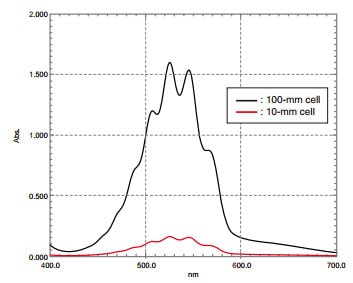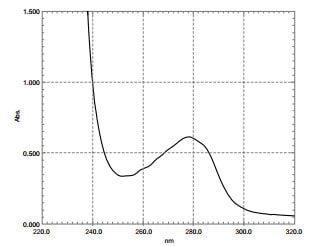Cell Types and Their Selection
The analysis of solutions is a common application of measurement performed using ultraviolet-visible spectrophotometers. There are many types of cells used for solution analysis. Depending on the material, optical path length, and volume of a cell, its application and purpose vary, as do the points that need to be observed in their use. Here, we look at the features of the various types of cells as well as some of the points to consider in their use.
1 Cell Material

Table 1 Measurement Wavelength Ranges for Cells of Different Materials
The material of the cell must have no absorption at the measurement wavelength. Two materials often used for cells are glass and quartz. Polystyrene (PS) and polymethylmethacrylate (PMMA) are mainly used for disposable cells. Table 1 indicates the wavelengths for which the different types of cells can be used.

Fig.1 Transmittance of Different Types of Cells
In this way, the measurable wavelength range varies according to the cell material. Fig. 1 shows the transmission spectra obtained for different types of cells using air as the object of measurement. It can be seen that there is no absorption by the cells in the measurement wavelength ranges given in Table 1.
In addition to measurement wavelength, there is also the issue of chemical resistance. Except for use with strongly alkaline solutions, glass and quartz have extremely good chemical resistance. With resin cells, however, the chemical resistance varies with the material, so care is required when selecting the cell used for measurement. Another point to be noted is that there are small differences in the optical path lengths of individual disposable cells, which are generally discarded after use. This may lead to errors in quantitative values. First, the cell type (material) is selected in accordance with the measurement wavelength and the solvent used.
2 Analysis of Low-Concentration and High-Concentration Samples

Fig.2 Absorption Spectra of Potassium Permanganate (Optical Path Lengths: 100 mm and 10 mm)
Cells with an optical path length of 10 mm are used in many different types of solution analyses. If the sample concentration is low, however, it may not be possible to obtain sufficient absorbance with a cell of this size. Although concentrating such samples allows the use of 10-mm cells, concentration is difficult in cases where the sample vaporizes or undergoes a chemical change during the concentration process. In such cases, measurement using a "long-path cell" is effective. There are long-path cells with optical path lengths of 20 mm, 50 mm, and 100 mm. The absorbance increases in proportion to the optical path length of the cell. Fig. 2 shows the results obtained by analyzing a 10-mg/L potassium permanganate solution with a 10-mm cell and a 100-mm cell. It can be seen that the absorbance of the 100-mm cell is ten times that of the 10-mm cell.

Fig. 4 Absorption Spectrum of Bovine Serum Albumin (Supermicro Cell; Sample Volume: 50 μL)
In the case of high-concentration samples, diluting the sample allows measurement with a 10-mm cell. There are samples, however,that cannot be diluted easily. For example, due to interaction with the solvent, diluting a sample may cause a change in the absorbance i.e., a shift in the peak wavelengths).
A well-known application of measurement using a short-path cell is solution analysis in the near-infrared region. If a 10-mm cell is used for measurement in the near-infrared region, saturation often occurs due to absorption by the solvent, making it impossible to ascertain the absorption of the sample. A short-path cell is used to prevent absorption saturation due to the solvent. With low- and high-concentration samples, the optical path length of the cell is selected in accordance with the size of the absorbance or transmittance.
3 Analysis of Micro-Volume Samples

In cases where the volume of sample required for measurement with a 10-mm cell (i.e., 3 mL) is not available, using a cell that is specifically designed for the analysis of micro-volume samples is effective. Such cells include "semimicro cells" (required volume: 1 mL), "micro cells" (required volume: 400 μL), and "supermicro cells" (required volume: 50 to 100 μL). Although it depends on the size of the light beam obtained with the instrument used, in order to prevent the measurement beam striking parts other than the sample itself, a specialized cell holder is used with these kinds of cells. Fig. 4 shows the measurement results obtained for a sample using a supermicro cell (sample volume: 50 μL). With micro-volume cells, the intensity of the light that irradiates the sample is reduced and so the amount of noise increases somewhat. Nevertheless, it can be seen that good results are obtained.
In addition to these cells, there is a "3-μL capillary cell set for ultramicro volume measurement." The sample is put in an extremely narrow glass tube giving an optical path length of around 0.5 mm. This enables measurement with a sample volume of only 3 μL. Well-known applications of analysis using micro-volume cells include the analysis of nonionic surfactants in water and the quantitation of protein extracts and DNA. When only a small volume of sample is available, the cell is selected in accordance with this volume.
4 Analysis of Volatile Samples
Here, focusing on cells that are commonly used, we have looked at the features of these cells as well as some points to note in their use. In addition to these, various other types of cells are commercially available, including an assembly-type cell with an extremely short optical path length of 0.05 mm (50 μm) and a cell that allows measurement with an optical path length of 10 mm to be performed with a sample volume of only 10 μL. Using a cell that is suitable for the application enables simple and accurate measurement.
5 Summary
Here, focusing on cells that are commonly used, we have looked at the features of these cells as well as some points to note in their use. In addition to these, various other types of cells are commercially available, including an assembly-type cell with an extremely short optical path length of 0.05 mm (50 μm) and a cell that allows measurement with an optical path length of 10 mm to be performed with a sample volume of only 10 μL. Using a cell that is suitable for the application enables simple and accurate measurement.




